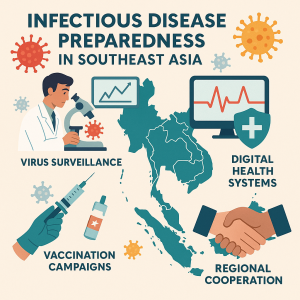Infectious Disease Preparedness in Southeast Asia: 2025 Trends and Strategies
2025 Infectious Disease Trends in Southeast Asia Meta Description: Explore how Southeast Asia strengthens infectious disease preparedness in 2025 through AI, diagnostics, and regional health innovation.
 Introduction
Introduction
In 2025, Southeast Asia continues to face challenges from endemic and emerging infectious diseases such as dengue, measles, tuberculosis, and novel respiratory viruses. After the COVID-19 pandemic, countries in the region have redefined what preparedness means. The focus is now on early detection, regional coordination, and digital health innovation, including the deployment of advanced diagnostics and AI-driven surveillance systems.
1. The Post-COVID Shift: From Reactive to Proactive
COVID-19 revealed vulnerabilities in public health infrastructure across the ASEAN region. In response, governments are moving from crisis-based models to proactive preparedness strategies. This includes:
- National stockpiles of diagnostic kits
- Integrated disease surveillance systems
- Investment in outbreak simulation and forecasting tools
Countries like Vietnam, Singapore, and Malaysia are leading the way with integrated national plans that involve both public and private sectors.
2. High Priority Diseases in 2025
While COVID-19 still lingers with emerging variants (like JN.1 and LF.7), several other diseases are taking center stage:
- Dengue Fever: Record outbreaks reported in Thailand and the Philippines
- Measles: Resurgence due to disrupted vaccination campaigns during the pandemic
- Avian Influenza: Regional monitoring remains critical
- Tuberculosis (TB): WHO flags Southeast Asia as a key zone requiring improved detection
The emphasis on multi-pathogen detection has increased demand for next-generation diagnostic platforms.
3. The Role of Technology in Preparedness
Digital and AI-powered tools are becoming the backbone of infectious disease management in Southeast Asia:
- AI-based outbreak prediction models for dengue and flu
- Wearable biosensors for continuous vital sign tracking in high-risk communities
- Cloud-connected diagnostic devices for real-time national reporting
- Mobile health apps for vaccination, symptom tracking, and public alerts
These tools are being piloted in Indonesia, Thailand, and Vietnam through government health innovation initiatives.
4. Diagnostics at the Core: Export Opportunities
Rapid, accurate diagnostics are essential for both prevention and control. Devices in high demand include:
- Biochemical analyzers for liver, kidney, and inflammatory markers
- Nucleic acid extraction systems for viral detection (COVID-19, flu, dengue)
- Point-of-care test kits for remote community health centers
Exporters offering ISO/CE-certified diagnostic solutions have strong opportunities in:
- Government procurement programs
- Private hospital and clinic expansions
- Humanitarian health NGO partnerships
5. Regional Collaboration and Preparedness Frameworks
ASEAN is strengthening regional resilience through cross-border disease monitoring. Key initiatives include:
- The ASEAN BioDiaspora Virtual Centre: Tracks emerging health threats via digital data
- WHO’s South-East Asia Regional Office programs: Capacity building and policy alignment
- Shared health intelligence platforms: Real-time alerts and case mapping
These frameworks are improving transparency and response speed across borders.
6. Challenges to Address
Despite progress, gaps remain:
- Rural infrastructure is still limited in parts of Indonesia, Myanmar, and Laos
- Vaccine hesitancy and public health misinformation hinder campaign effectiveness
- Data interoperability across platforms remains inconsistent
- Funding shortfalls can stall large-scale AI deployment
Solving these issues will require sustained investment and international collaboration.
Conclusion
As Southeast Asia advances into 2025, its approach to infectious disease preparedness has become smarter, faster, and more technology-driven. With governments embracing AI, next-gen diagnostics, and regional collaboration, the region is better equipped to detect, manage, and prevent outbreaks. For global health innovators and exporters, this transformation offers a growing, dynamic market with a strong demand for cutting-edge medical technologies.
👉 Explore smart diagnostic solutions and export opportunities at www.xinrea.com
